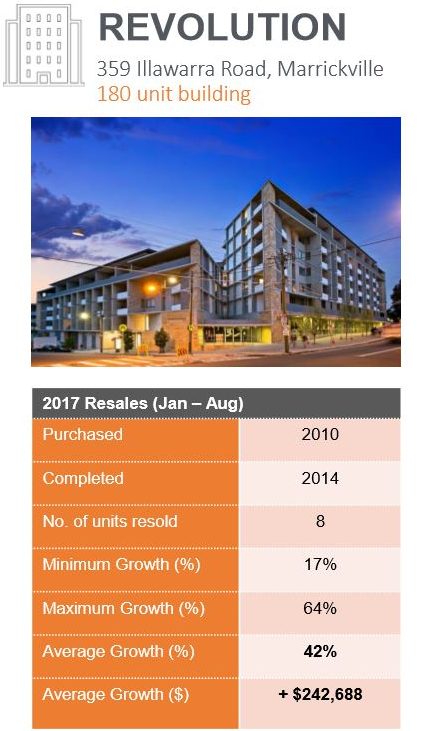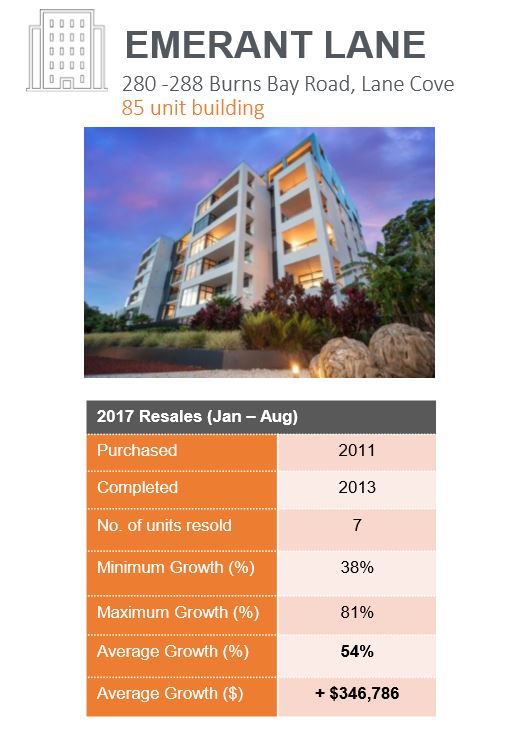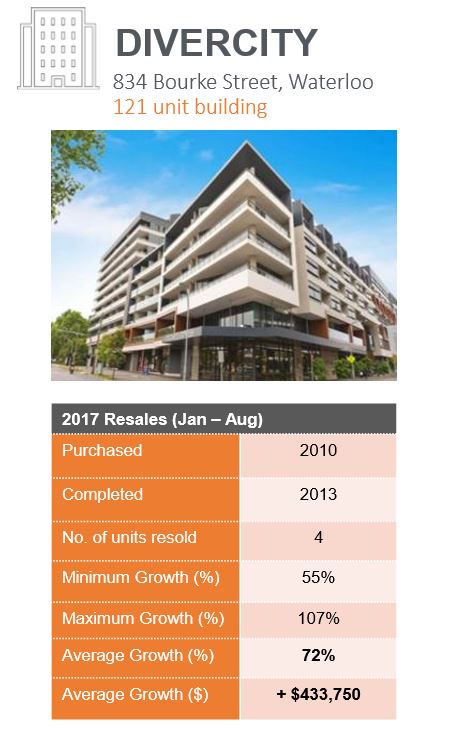Where did Ironfish customers buy investment property in Sydney – and why were they so successful?
It’s no secret that the property boom in Sydney of recent years has left many hopeful property investors priced out of premium or preferred Sydney suburbs. Since 2010, Sydney house values have increased by 82% and apartments by 71%. But there are also many investors who are now enjoying the benefits of gaining a foothold into the prized Sydney market, by seizing the right opportunity when it presented itself. So, what can investors learn from the Sydney market, with and without the benefit of hindsight?
Our property and projects team conducted a review of 2017 property re-sales in Sydney. They have published a case study of 6 properties we offered to investors from 2010-2013 – a couple of years before prices started to take off in earnest – to examine why these properties have been particularly successful investments and what investors can learn from these case studies to inform future investment decisions. We interviewed our National Property Director, Grant Ryan, to gain some valuable insights.

Grant Ryan, Ironfish Australia National Property Director
Q. With 20 years in the property industry, and as the head of the Ironfish projects team (meaning every property development we choose to offer our customers goes through you) what is your property selection process?
Grant: At Ironfish, we have two overall strategies: “infill” which generally refers to filling a little gap within an established suburb and “urban renewal” areas, such as Victoria Park Zetland or Rhodes. If you compare these suburbs today to 15 years ago, you can see the dramatic changes that have taken place.
Beyond location, it’s also about selecting the right development. Major factors we consider include transport, convenience for tenants and future owners, employment and lifestyle factors.
After that it comes down to the quality of the development; we want to make sure that the property has future appeal to people i.e. who is going to pay a lot more money for this property in the future. And this has to do with who is the developer, what’s their experience and a lot of what I call – “off-market intel” – we’ve been in the market a long time, we’re looking for opportunities that other people don’t have.
“A good example is “Revolution” in Marrickville: who would have thought at the time that a $599K apartment would be sold in 5 years for nearly $1 million?”

Q. What was the Sydney market like in 2010 – 2012 just before the property boom?
All the property markets have a cycle; the major problem is that people tend to get out too early and get in too late.
After a period of strong growth in 2000 – 2003, in the following five years from 2004 to 2008, Sydney’s property market was flat, and then this period was prolonged by the GFC. In 2010, the Sydney market was starting to heat up, but only a little.
“It was still very, very difficult to convince people to buy property in Sydney. Investors were thinking about the recent past – how is it possible that values will go up again?”
Over the years, we’ve always tried to improve the quality of the developments we choose, but ultimately, what we’ve learned is that the best time to buy and when you will make the most money is not when it’s the easiest time to buy.
Even though, in hindsight, many investors would have loved to invest or invest more in the Sydney market, these 6 properties are good examples of when investors still needed some guts to get into the market.
Q. What areas or suburbs were we focusing on back in 2010 and why?
At the time, our take on the market was that the more prestigious areas of Sydney presented a real opportunity; as they were still affordable, and after the next cycle were likely to become unaffordable. So we thought that inner-Sydney suburbs and lower north shore were very good opportunities; they had real demand and were already very established, but with fresh infrastructure going in as well.
At the same time, the inner west was also on our radar; Marrickville was still a bit of an “ugly duckling” suburb back then, our challenge at the time was finding the right development. The precincts around Olympic Park were very under-developed and we also saw potential there.
“The one big thing these 6 suburbs have in common is that they are all located in highly desirable suburbs – places where people actually want to live, now and in future and they have strong owner occupier appeal. These are suburbs that are simply unaffordable now, for many people.”

“We recognised that Emerant Lane in Lane Cove, had genuine owner-occupier appeal: it was well designed, by a good developer, well-priced and in an established, premium location. Some people rejected this at the time because it wasn’t located right next to a station, but it has outperformed some of these types of developments because of its owner-occupier appeal.”
Q. For investors who’ve made money in the Sydney market – what should their next strategy be?
At Ironfish we believe that every city has its own property cycle – once you have equity – what do you do? Do you keep investing exclusively in the Sydney market? We would suggest that’s not the wisest thing to do, because you have all your eggs in one basket.
Particularly, as experienced investors recognise, if your market is at a peak, it may be some time before you see the same type of growth again. We suggest now would be a good time to access equity and leverage off some of the other cities which can offer better value for money, in terms of quality and location.
Q. For those who haven’t invested in Sydney yet, is it too late?
There’s always opportunity in every market! The truth is that the “Sydney market” is not just one market. There are many different markets – each of which performs differently. E.g. Sydney’s North and Inner West markets are quite different, as are comparing the East and South-West. Then, of course, there’s the prestige market, the affordable market, mid-market, new properties, second-hand market etc.
“There’s still opportunities out there, but now you need to do even more research and target markets that are not yet at their peak, and that’s our focus.”

“Waterloo is an urban renewal area that has changed dramatically over the last 10 years. Divercity investors have achieved up to 107% capital growth.”
Q. What can we learn from the market performance in Sydney of the last 5-7 years?
If you go back in time, what we’ve learned over the years is that very rarely is there a market where it’s easy to buy. It’s only looking back on it that you suddenly realise it was a great time to buy – so perspective is a really interesting thing for property investors! It’s also a bit like “Groundhog Day”. Every decade people think property is too expensive, how will it possibly go up? How can my children afford it? And then, Groundhog Day comes again, and again. The only thing you don’t know is when.
“Because you don’t know when the market cycle is going to go up – the property needs to be easy to hold, with a low vacancy rate and lots of future tenant and owner-occupier appeal.”
Trust is also a big issue – people may trust the recommendations of friends and acquaintances, even if they lack expertise, rather than talking to a professional when making a purchasing decision.
At the end of the day, at any given time, people will have different points of view about whether it’s the best or worst time to buy. What we can see, however, is that Groundhog Day happens every decade, and when you look back to ten years ago, prices seem much more affordable and people inevitably wish they had invested more.
At Ironfish, we believe in the long-term property markets of the 5 major cities in Australia: Sydney, Melbourne, Brisbane, Adelaide and Perth. We have local offices in each of these cities, and we also offer different types of properties: apartments, house and land and townhouses – this gives our customers flexibility and confidence that we’re only recommending property where we have a local office and local knowledge.
“We believe in the Portfolio Approach – which means investing in your local market, as well as other cities, with a mix of property types.”

“Belvedere was one of the first Sydney developments to feature the design trend – that originated in Melbourne – of elevated rooftop amenity areas for residents. These areas have strong appeal for residents; they become an extension to their own living spaces, and allow universal access to stunning rooftop views.”

“For people who invest in under-developed areas, you can really start to see an increase in capital growth once they are built out and the infrastructure of the suburb is established.”

“A 2bdrm apartment in Montrose achieved 55% capital growth in two years after settlement, but had a higher initial price point than a 1bdrm. On the other hand, 1bdrm apartments always attract tenants and can offer strong rental yield.”
If you want further details and re-sale data on the 6 properties featured in our Sydney market case study, or would like information about buying investment property in Sydney, please download our property report or contact your local Ironfish Strategist.